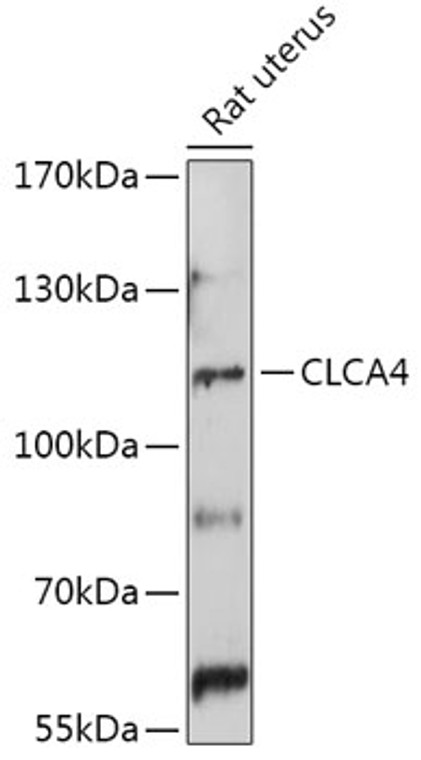| Host: |
Rabbit |
| Applications: |
WB |
| Reactivity: |
Human/Rat |
| Note: |
STRICTLY FOR FURTHER SCIENTIFIC RESEARCH USE ONLY (RUO). MUST NOT TO BE USED IN DIAGNOSTIC OR THERAPEUTIC APPLICATIONS. |
| Short Description: |
Rabbit polyclonal antibody anti-CLCA4 (22-150) is suitable for use in Western Blot research applications. |
| Clonality: |
Polyclonal |
| Conjugation: |
Unconjugated |
| Isotype: |
IgG |
| Formulation: |
PBS with 0.01% Thimerosal, 50% Glycerol, pH7.3. |
| Purification: |
Affinity purification |
| Dilution Range: |
WB 1:500-1:2000 |
| Storage Instruction: |
Store at-20°C for up to 1 year from the date of receipt, and avoid repeat freeze-thaw cycles. |
| Gene Symbol: |
CLCA4 |
| Gene ID: |
22802 |
| Uniprot ID: |
CLCA4_HUMAN |
| Immunogen Region: |
22-150 |
| Immunogen: |
Recombinant fusion protein containing a sequence corresponding to amino acids 22-150 of human CLCA4 (NP_036260.2). |
| Immunogen Sequence: |
SFIKLNNNGFEDIVIVIDPS VPEDEKIIEQIEDMVTTAST YLFEATEKRFFFKNVSILIP ENWKENPQYKRPKHENHKHA DVIVAPPTLPGRDEPYTKQF TECGEKGEYIHFTPDLLLGK KQNEYGPPG |
| Tissue Specificity | Primarily expressed in the digestive tract, mainly in colon. Detected in smaller amounts in brain, urogenital organs, testis, and salivary and mammary glands. Highly expressed in the epithelial layer and submucosal gland of the inferior turbinate mucosa. Lower levels in the epithelial layer of nasal polyp. |
| Post Translational Modifications | The translation product is autoproteolytically cleaved by the metalloprotease domain in the endoplasmic reticulum into a N-terminal and a C-terminal products that remain physically associated with each other. The cleavage is necessary for calcium-activated chloride channel (CaCC) activation activity. |
| Function | May be involved in mediating calcium-activated chloride conductance. |
| Protein Name | Calcium-Activated Chloride Channel Regulator 4Calcium-Activated Chloride Channel Family Member 4Hclca4Calcium-Activated Chloride Channel Protein 2Cacc-2Hcacc-2Chloride Channel Accessory 4 Cleaved Into - Calcium-Activated Chloride Channel Regulator 4 - 110 Kda Form - Calcium-Activated Chloride Channel Regulator 4 - 30 Kda Form |
| Database Links | Reactome: R-HSA-2672351 |
| Cellular Localisation | Cell MembraneSingle-Pass Membrane ProteinApical Cell MembraneSecretedThe C-Terminus 30 Kda Form Is Anchored To The MembraneThe N-Terminus 110 Kda Form Is Released From The Membrane Triggered By An Unknown Stimulus |
| Alternative Antibody Names | Anti-Calcium-Activated Chloride Channel Regulator 4 antibodyAnti-Calcium-Activated Chloride Channel Family Member 4 antibodyAnti-Hclca4 antibodyAnti-Calcium-Activated Chloride Channel Protein 2 antibodyAnti-Cacc-2 antibodyAnti-Hcacc-2 antibodyAnti-Chloride Channel Accessory 4 Cleaved Into - Calcium-Activated Chloride Channel Regulator 4 - 110 Kda Form - Calcium-Activated Chloride Channel Regulator 4 - 30 Kda Form antibodyAnti-CLCA4 antibodyAnti-CaCC2 antibodyAnti-UNQ562 antibodyAnti-PRO1124 antibody |
Information sourced from Uniprot.org
12 months for antibodies. 6 months for ELISA Kits. Please see website T&Cs for further guidance








